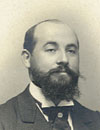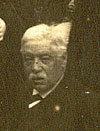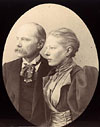About the Van Marken photo album
The social entrepreneur
Social entrepreneurs surfaced in 19th and 20th century social history of the Western world in many countries. Understandably, they made their first appearance in the most developed European nations, such as the United Kingdom and France.
The United Kingdom
England brings to mind individuals such as John Stuart Mill (1806-1873) and Robert Owen (1771-1858). Mill, a theoretician of utilitarianism, advanced a laissez-faire ideology that considered the rights of workers in increasing measure. Owen also made a practical effort to redesign and especially to improve the world. From 1800 until 1825 he ran the community and cotton factories in New Lanark, Scotland, and founded New Harmony in the United States.
France
French sources also reflect an early desire to reform capitalism or even transcend the system by forming producer communities (i.e. the parties responsible for production). F.M.C. Fourier (1772-1837) was unquestionably the most influential person in this movement. His ideas about establishing phalanges (productive communities in which people were compensated according to the return for the community as a whole) were carried out on several occasions.
Jean Godin
Among Fourier's disciples was the entrepreneur Jean-Baptiste André Godin (1817-1888). From the 1840s onward, Godin developed his factory for stoves and heaters. During the same period he embraced Fourierism and tried to apply his ideas about social entrepreneurship. He opened his factory in Guise, in Northern France. From 1856 the familistère (the settlement of workers in Godin's factory) was located there as well. The concept featured communal accommodations in homes overlooking a common, covered courtyard. The main idea was that the community of people involved in the factory would become the owner as well.
Jules Prudhommeaux
 After Godin's death, the workers inherited the factory and the rest of the estate. Jules Prudhommeaux (1869-1948), who was married to Marie-Jeanne Dallet (the cousin of Godin's second wife), was one of the leading figures in continuing the familistère. Prudhommeaux was active in the peace movement and advocated cooperatives as social reform instruments. He also took a keen interest in the history of 'experimental socialism': concrete communities dedicated to applying socialist ideals in practice. From the moment the IISH opened its branch in Paris (1936), Jules Prudhommeaux was involved in the organization and served on its advisory board. He and his son André (who was born in the familistère) helped the IISH obtain a wealth of material about what has become known as Utopian Socialism.
After Godin's death, the workers inherited the factory and the rest of the estate. Jules Prudhommeaux (1869-1948), who was married to Marie-Jeanne Dallet (the cousin of Godin's second wife), was one of the leading figures in continuing the familistère. Prudhommeaux was active in the peace movement and advocated cooperatives as social reform instruments. He also took a keen interest in the history of 'experimental socialism': concrete communities dedicated to applying socialist ideals in practice. From the moment the IISH opened its branch in Paris (1936), Jules Prudhommeaux was involved in the organization and served on its advisory board. He and his son André (who was born in the familistère) helped the IISH obtain a wealth of material about what has become known as Utopian Socialism.
Auguste Fabre
 The archive of Prudhommeaux also comprises 15 small photo albums compiled by Auguste Marie Fabre (1839-1922). Fabre operated in the same circles as Prudhommeaux. He supported cooperative principles and worked for Godin from 1879 onward. Fabre was fascinated with the cooperative and Utopian movements in the United States.
The archive of Prudhommeaux also comprises 15 small photo albums compiled by Auguste Marie Fabre (1839-1922). Fabre operated in the same circles as Prudhommeaux. He supported cooperative principles and worked for Godin from 1879 onward. Fabre was fascinated with the cooperative and Utopian movements in the United States.
Photo albums
One of the albums is devoted to Icaria, the commune in the United States that Jules Prudhommeaux described. Among the remaining albums, two concern Fourier, one is about French consumer cooperatives and another about the productive cooperative movement in France, two deal with the Maison du Peuple in Brussels, two address the La Houille Blanche paper factory, two review peace and arbitration, while the others cover Rochdale, productive labour associations, Robert Owen, the Swiss and British consumer cooperatives and the Van Marken institutions in Delft (around 1895). The albums, though simple, are packed with duplicated photographs, of which some are reprinted from books and others from the originals. Many photographs are missing. In some cases handwritten texts accompany photographs that may or may not appear in the album. The call number of this album is BG T2/31.
J.C. van Marken
 The album about a Dutch subject amid this non-Dutch collection is not truly surprising. Van Marken was highly dedicated. He directed his efforts to interest a foreign public more toward German and French speakers than toward English ones. Jacob Cornelis van Marken (1845-1906) was the son of an Amsterdam preacher. He left the Dutch Reformed Church and became a Remonstrant in Delft. In 1869 he married Agneta Wilhelmina Johanna Matthes. Her sister (i.e. Van Marken's sister-in-law) was the wife of Lower House member A. Kerdijk, who brought Van Marken in touch with these circles of progressive liberals and radicals. He attended the Polytechnic School in Delft, which is now Delft Technical University.
The album about a Dutch subject amid this non-Dutch collection is not truly surprising. Van Marken was highly dedicated. He directed his efforts to interest a foreign public more toward German and French speakers than toward English ones. Jacob Cornelis van Marken (1845-1906) was the son of an Amsterdam preacher. He left the Dutch Reformed Church and became a Remonstrant in Delft. In 1869 he married Agneta Wilhelmina Johanna Matthes. Her sister (i.e. Van Marken's sister-in-law) was the wife of Lower House member A. Kerdijk, who brought Van Marken in touch with these circles of progressive liberals and radicals. He attended the Polytechnic School in Delft, which is now Delft Technical University.
Nederlandsche Gist- en Spiritusfabriek
Toward the end of his studies, Van Marken discovered that Dutch yeast production was deficient. At the time yeast production was a sideline of Schiedam's gin distilleries. The availability of their yeast was irregular and the quality very mixed. This situation made bread production inefficient. Van Marken learned about a reliable procedure in Austria and founded the Nederlandsche Gist- en Spiritusfabriek [Dutch yeast and methylated spirits factory] in 1869.
Social welfare
From the outset Van Marken aimed to be more than simply an entrepreneur. Over the years he set up a vast network within his operations, which bore a striking resemblance to what later became the welfare state in industrialized economies. He promoted employee savings and arranged insurance to cover sickness, accidents and death. He made employees joint owners of the firm by saving shares. Those employed at the Nederlandsche Gist- and Spiritusfabriek even received a few paid holidays. From 1875 Van Marken provided co-determination in the firm by forming a council that he named de Kern [the core].
Agneta park
In 1884 Van Marken set up the limited liability company Gemeenschappelijk Eigendom [joint property]. The objectives of this firm included: 'Building and letting proper residences, boarding houses, workplaces, shops, laundry and bathhouses on tracts of land to be purchased in the Agneta Park.' The residences in this specially designed park were to be let to the workers of the Nederlandsche Gist- en Spiritusfabriek. Part of the rent was to be converted into shares. Eventually, the residential collective would own the Agnetapark homes. Van Marken and his wife settled there too and had a residence built, which they programmatically named Rust Roest [rust rusts]. The park accommodated a community activity centre as well.
Criticism
Van Marken's dream did not come true. The proceeds of the rents were insufficient for the residents to become collective owners within a reasonable time frame. Moreover, the paternalist system of living in a park with the highest boss at the factory employing the tenants elicited criticism. Nonetheless, the Agnetapark illustrated the emergence of the idea of a community surrounding a firm and a suburb for workers.
At the end of the 19th century Van Marken's ideas drew criticism from both the left and the right wing. Social reality virtually precluded the ideal of harmonious coexistence of the interests of capital and labour. Van Marken's motto 'All for the factory, the factory for all' improved the personal fates of many individual workers. The general condition of Dutch society, however, was not conducive to widespread application of such ideas at the time.
Nineteenth-century experimental or Utopian Socialism is covered in a wealth of material at the IISH. The subject is also highlighted in the Catalogue of titles on Utopian Communities, Colonies, Communes and other Experiments in Living Together on our site.
Finding aids of the archives André Prudhommeaux and Jules Prudhommeaux can be consulted online.
